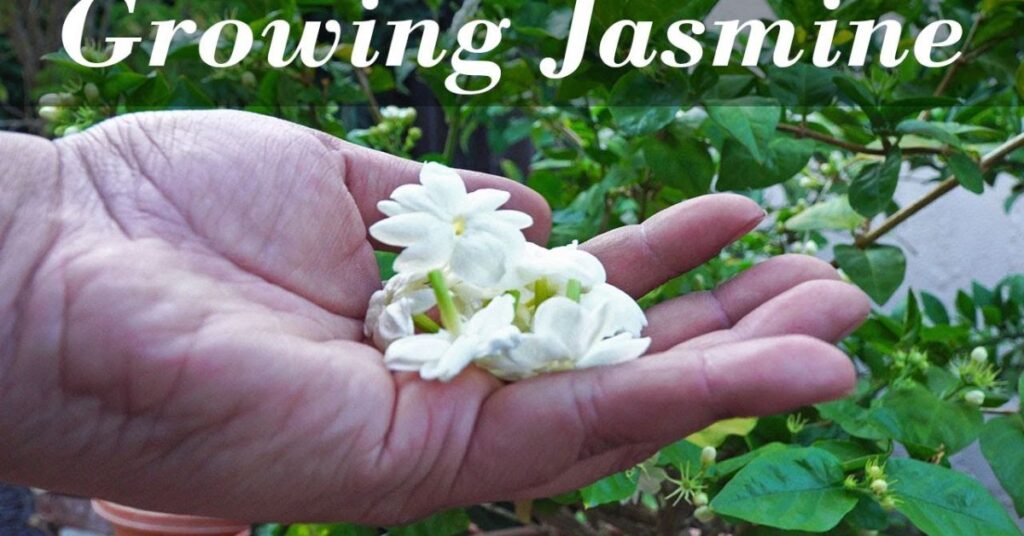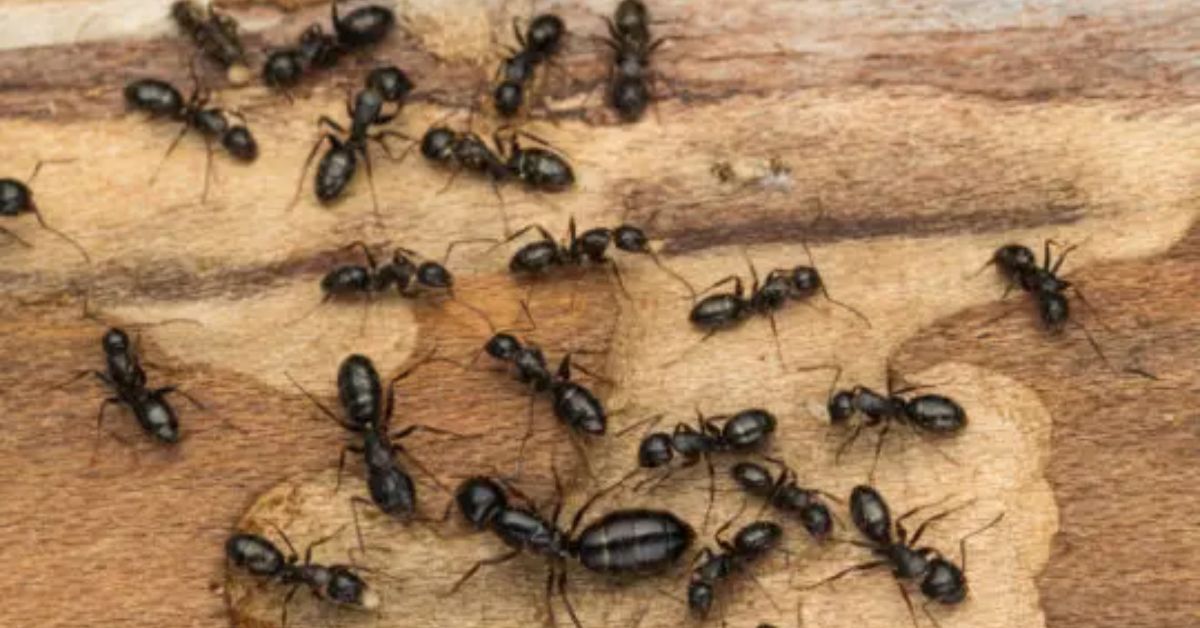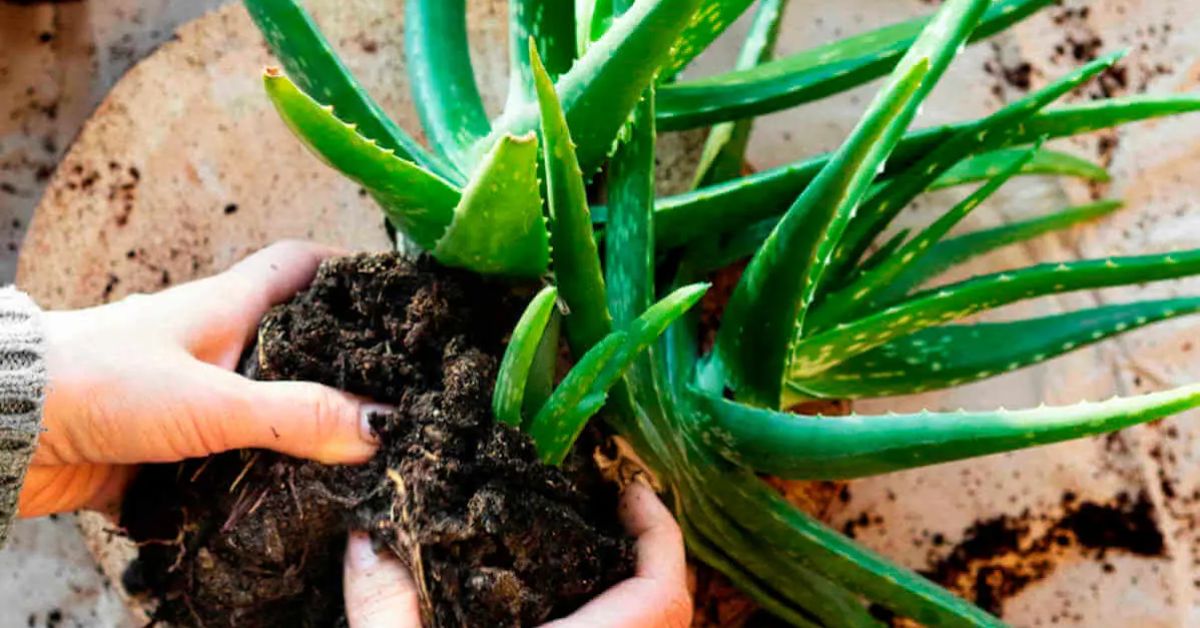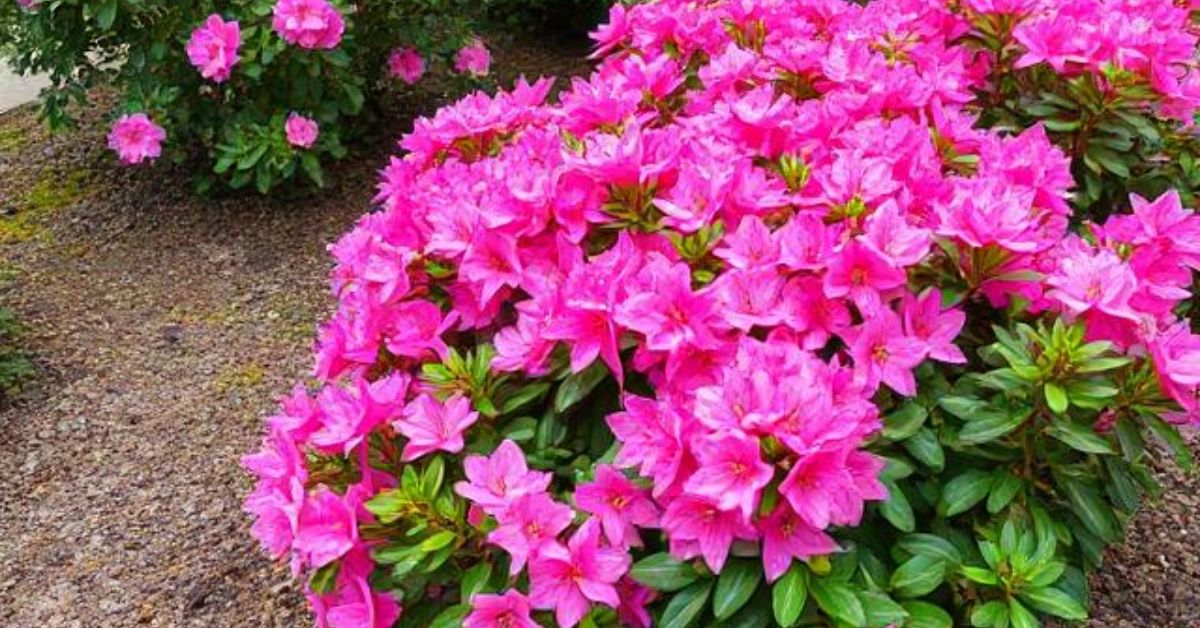Jasmine is one of the most beloved flowering plants, known for its intoxicating fragrance and beautiful blooms. Whether you want to enhance your garden with its elegant white or yellow flowers or enjoy its scent indoors, trellis ideas for jasmine is an excellent addition to any space.This adaptable shrub can be cultivated in gardens., pots, or indoors, making it a favourite among gardening enthusiasts. Its flowers are often used in perfumes, teas, and essential oils due to their soothing aroma and medicinal properties.
Growing jasmine plant white flowers may seem challenging, but with the proper care, it thrives beautifully. In this guide, we’ll walk you through everything you need to know about growing Jasmine, from selecting the right variety to maintaining healthy, vibrant plants. Whether you are a beginner or an experienced gardener, this guide will help you cultivate a thriving jasmine plant that fills your home or garden with its signature fragrance.
Jasmine Care Guide
Jasmine plants can thrive in gardens, containers, or as houseplants. Outdoor vining varieties require support, while container-grown and indoor Jasmine should be pruned for a more compact shape.
Growing Conditions
- Sunlight: Plant jasmine in a location with at least six hours of direct sunlight daily.
- Soil: Use well-draining, organically rich loamy soil. The No-Brainer Guide to Starting Seeds Indoors For potted plants, mix in bark and peat moss. A pH of 6.5 to 7.5 is the ideal range.
- Watering: Keep the soil moist but not drenched.
- Water garden plants weekly, increasing frequency in hot weather. Potted plants may need watering 2–3 times per week when the top inch of soil is dry. Reduce watering during winter.
- Temperature & Humidity: Maintain temperatures between 60–75°F. Jasmine thrives in warm conditions but is sensitive to frost, except for cold-hardy varieties like winter jasmine.
- Support & Shelter: Provide trellises or stakes for vining jasmine and protect plants from strong winds.
Light Requirements
Providing sufficient light is essential for Jasmine to bloom.Every day, the majority of species need at least six hours of direct sunlight. Summer-blooming varieties thrive in full sun while winter-blooming types prefer partial shade. Jasmine grown in low light will produce fewer flowers.
Fertilizing Jasmine
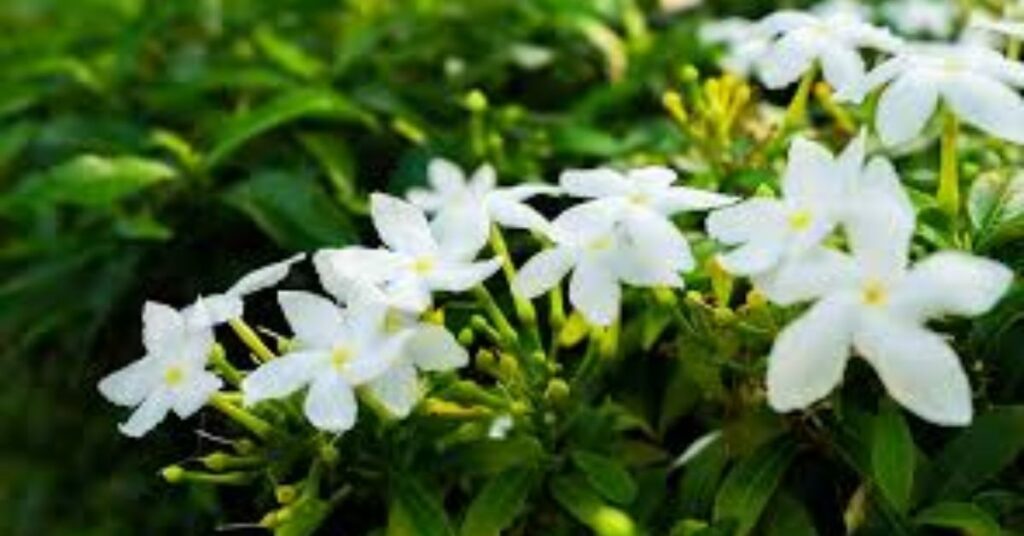
- Garden Jasmine: Typically requires little to no fertilization. Apply mulch or compost in spring to replenish nutrients.
- Potted Jasmine: In early spring, feed Using liquid fertilizer or slow-release granular fertilizer every two weeks during the spring and summer.If flowering is poor, use a high-phosphorus fertilizer (NPK 7-9-5) to encourage blooms.
Following these care guidelines, your jasmine plants will flourish with lush foliage and fragrant blooms.
Types of Jasmine
There are many varieties of Jasmine, each with unique characteristics, scents, and growth habits. Choosing the right type depends on your climate and space and whether you want it for ornamental purposes, fragrance, or medicinal uses. Below are some of the most popular jasmine varieties:
Common Jasmine (Jasminum officinale)
- Also known as “Poet’s Jasmine,” this is one of the most popular and fragrant varieties.
- Produces clusters of white, star-shaped flowers with a strong, sweet scent.
- A fast-growing climber that thrives in warm climates and needs full sun.
- Ideal for fences, trellises, and walls.
Arabian Jasmine (Jasminum sambac)
- It is famous for its intensely fragrant white flowers, often used in teas and perfumes.
- A small shrub or vine can be grown in pots or on the Ground.
- Blooms year-round in warm climates and requires moderate sunlight.
- The national flower of the Philippines is widely used in religious and cultural ceremonies.
Star Jasmine (Trachelospermum jasminoides)
- It is not a true jasmine, but it closely resembles it in appearance and fragrance.
- yields tiny, fragrant, white, star-shaped flowers.
- A hardy, evergreen climber that works well for ground cover, fences, and walls.
- Tolerates a variety of conditions, making it an excellent low-maintenance option.
Winter Jasmine (Jasminum nudiflorum)
- Unique for its bright yellow flowers that bloom in winter or early spring.
- Unlike other jasmines, it has little to no fragrance.
- A hardy and adaptable plant, perfect for colder climates.
- Often used for ground cover or cascading over walls.
Spanish Jasmine (Jasminum grandiflorum)
- Sometimes called “Royal Jasmine”, this variety is known for its large, white flowers and strong scent.
- frequently utilized in the creation of fragrances and essential oils.
- A fast-growing vine that thrives in warm, tropical climates.
- Needs plenty of sunlight and regular pruning for the best growth.
Pink Jasmine (Jasminum polyanthum)
- Recognized for its pink buds that open into small, white, fragrant flowers.
- A vigorous, fast-growing climber that is ideal for covering trellises and fences.
- Blooms profusely in late winter and early spring.
- Thrives in full to partial sunlight and well-drained soil.
Italian Jasmine (Jasminum humile)
- A bright yellow flowering jasmine with a mild scent.
- It can be grown as a shrub or vine and is more compact than other jasmine varieties.
- An excellent choice for container gardening or hedges.
- Drought-tolerant once established, making it ideal for warm and dry regions.
Wild Jasmine (Jasminum fruticans)
- A semi-evergreen shrub with small, yellow flowers that bloom throughout the summer.
- Less fragrant compared to other jasmines but still attractive in gardens.
- Grows well in rocky, dry soils and is resistant to drought.
- Often used in natural landscaping and erosion control.
Forest Jasmine (Jasminum abyssinicum)
- A rare variety native to Africa, known for its climbing ability and sweet-smelling flowers.
- Produces clusters of white, tubular flowers with a hint of pink.
- Prefers warm, tropical environments with high humidity.
Choosing the Right Jasmine for Your Garden
When selecting a jasmine variety, consider:
- Climate: Certain types are more appropriate for warm, How Banana Flowers tropical weather, while others can tolerate colder conditions.
- Growth Habit: Decide whether you want a climbing vine, shrub, or ground cover.
- Fragrance: If scent is essential, choose fragrant varieties like Arabian or Spanish.
- Space: Some jasmines need much space to spread, while others can grow in containers.
With the proper selection, Your garden or house can benefit from the lovely and aromatic addition of jasmine.
How to Plant Jasmine
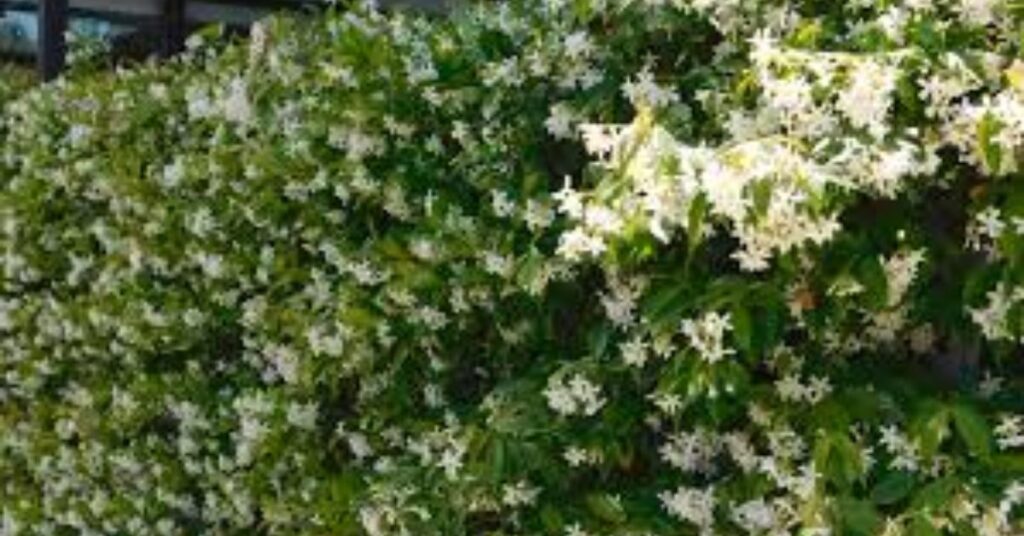
Planting Jasmine correctly is essential for healthy growth and beautiful blooms. Proper preparation and care will ensure your Jasmine thrives, whether growing it in the garden or a container. Quick and Easy Ways Follow these steps to plant Jasmine successfully.
Choosing the Right Location
Jasmine plants thrive in full to partial sunlight. Pick a location A location with four to six hours of sunlight every day is ideal.
If you are planting a climbing type, be sure that it is supported by a wall, fence, or trellis.
Indoor plants should be placed in a pot close to a bright window that receives indirect sunlight.
Preparing the Soil
- Jasmine prefers well-draining, rich soil. A mix of loamy or sandy soil with organic matter works best.
- The ideal soil pH is 6.0 and 7.5 (slightly acidic to neutral).
- Before planting, apply compost or well-rotted manure to the soil to improve its quality.
Planting Jasmine in the Ground
Step 1: Digging the Hole
- Dig twice as deep and as wide as the root ball of the plant.
- Loosen the dirt at the bottom to encourage Are Those Stripes Safe the formation of roots.
Step 2: Plant Positioning
- The jasmine plant should be carefully taken out of its container.
- Before planting, loosen any firmly connected roots a little.
- Position the plant in the hole so that the soil surface and the top of the root ball are level.
Step 3: Watering and Filling
- Press down gently to remove any air pockets as you fill the hole with dirt.
- To aid in the soil’s settlement around the roots, give them plenty of water.
- For moisture retention and weed control, How to Grow Tulips cover the base with a layer of mulch (such as bark or straw).
Watering and Initial Care
Keep the soil moist but not soggy. When you feel that the top inch of soil is dry, water deeply.
In the winter, when jasmine goes dormant, irrigation should be reduced.
- For good development throughout the growing season, apply a balanced liquid fertilizer once a month.
Supporting Jasmine Growth
- If growing a climbing variety, tie the stems loosely to a trellis or support.
- Prune lightly after planting to encourage bushier growth.
Following these steps, your jasmine plant will establish strong roots and flourish, providing lush foliage and fragrant blooms.
Propagating Jasmine
propagating jasmine can be propagated in several ways, but stem cuttings are the easiest method for home gardeners. Cuttings are best taken in spring or early summer when new green growth develops. Take several cuttings to increase your chances of success.
Propagation Steps:
- Assemble a pot, light potting mix, rooting hormone (if using), a plastic covering, and a sterile cutting instrument.
- Select a healthy jasmine plant and cut six- to eight-inch-long stems, leaving only the top two or three sets of leaves.
- Fill a pot with moistened planting mix.
summer jasmine plant the clipped ends in the potting medium after dipping them in rooting hormone (optional).
- Cover the dirt with plastic and place it in bright indirect light to moisten it.
- Root development takes 4–6 weeks. Gently tug on the cutting; resistance indicates root formation.
- Once new plants grow to 3–4 inches tall, transfer them to a permanent container or garden.
Potting and Repotting Jasmine
jasmine vines thrives when slightly root-bound, producing more blooms. However, if roots emerge from the drainage holes, it’s time to repot into a container 1–2 inches larger.
- Repot every three years in early spring before new growth begins.
- For new nursery plants, choose a pot three times their current size.
- Select a well-draining pot that can support vining varieties. Heavy ceramic or clay pots help balance top-heavy plants.
- To improve drainage and nutrient absorption, The Best Types of Flowers for Every Garden Style and Climate use a light potting mix with bark, moss, perlite, or vermiculite.
Common Pests & Diseases
Pests
scented jasmine plant attracts various pests, including:
- Garden pests: Leaf-chewing caterpillars (budworms, leaf rollers, webworms). At the first indication, use horticultural oil.
- Houseplant pests: Aphids, spider mites, whiteflies, scale, and thrips. These sap-sucking insects cause yellowing or spotted leaves and webbing. Treat with insecticidal soap or, in severe cases, a targeted pesticide.
Diseases
- Fusarium wilt: A soil-borne fungus causing black, rotting roots. Treat the plant early with fungicide or relocate it after removing damaged roots.
- Rust: Causes red discoloration. Treat with copper-based fungicide.
- Leaf blight: Brown circular spots leading to curled, dried leaves, especially in wet conditions. Use targeted fungicide.
Encouraging Jasmine to Bloom
star jasmine on trellis flowers are best when kept warm, moist, and exposed to bright sunlight.
Blooming Patterns
- Different species bloom at various times: Pink jasmine blooms in late winter/early spring, while royal jasmine flowers are year-round in warm zones.
- Bloom duration: Some species bloom for 1–2 months, while others in warm climates bloom repeatedly throughout the year.
Appearance & Fragrance
- Jasmine flowers are single or double blooms, often tubular and star-shaped, with 5–9 petals.
- Colours range from white to yellow and pinkish-white.
- The scent is rich, sweet, fruity, and slightly musky, valued in aromatherapy and perfumery.
Boosting Blooms
- Garden plants: Work compost into the soil annually or use a slow-release fertilizer in early spring. Apply mulch to retain moisture.
- Container plants and houseplants: Feed them with diluted Apply slow-release fertilizer or liquid fertilizer every two weeks during the growing season.
Caring for Jasmine After Blooming
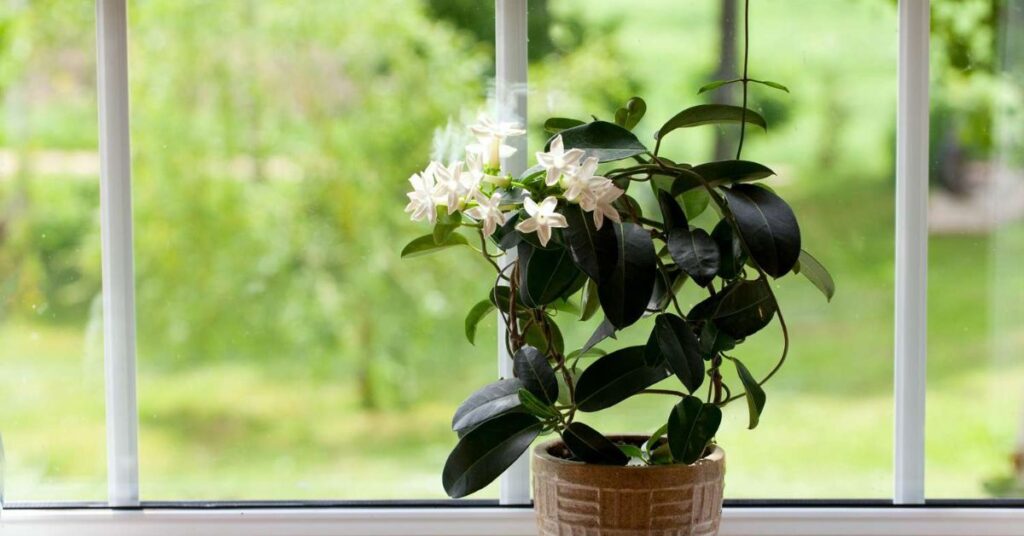
Pruning
Hard pruning after blooming keeps propagating jasmine compact and promotes future blooms. Reduce feeding and watering during the off-season for houseplants.
Deadheading Flowers
- Use sharp scissors or pruners to remove fading flowers at the base of the stem.
- Avoid damaging foliage while cutting.
- Deadheading encourages continuous blooming and keeps the plant healthy.
Following these care tips, your Jasmine will flourish with abundant blooms and a delightful fragrance.
How to Make Jasmine Bloom
Jasmine plants are known for their sweet, exotic fragrance and beautiful white or yellow blossoms. If your jasmine isn’t blooming, a few simple tricks can help it flourish. First, make sure your plant gets plenty of sunlight. Jasmine thrives in full to partial sunlight, needing at least 4 to 6 hours daily. Without enough light, it may grow leaves but no flowers.Maintain a steady watering schedule to keep the soil damp but not wet. Jasmine thrives in soil with a pH of 6.0 to 6.5 and good drainage. acidic. How to Grow Snapdragons Antirrhinum A surplus of water or underwatering can stress the plant, affecting its blooming cycle.
Fertilize with a balanced or phosphorus-rich fertilizer during the growing season (spring to late summer). Pruning is also essential. Trim your plant after flowering to promote new growth and more blooms.Temperature matters, too. Jasmine blooms best in warm weather, between 60–75°F (15–24°C). Protect it from frost and strong winds. If it’s in a pot, move it indoors when the temperature drops.Lastly, give your Jasmine some love! Regular attention, care, and patience will reward you with a lush, fragrant display. With the right mix of sun, water, and nutrients, your jasmine will bloom beautifully.
Conclusion
Growing star jasmine trellis is a rewarding experience that brings beauty and fragrance to any space. Whether you plant it in your garden, on a trellis, or in a pot indoors, proper care will ensure healthy growth and abundant blooms. By selecting the right variety, providing well-draining soil, watering correctly, and offering support for climbing types, you can enjoy the delightful scent and elegant flowers of jasmine year after year.
With patience and attention to its needs, jasmine bush will thrive and fill your surroundings with its enchanting aroma. Whether you’re a beginner or an experienced gardener, this This adaptable plant is a great complement to your collection. Start growing Jasmine today and enjoy its natural beauty and soothing fragrance!
FAQ
How long does it take for Jasmine to bloom?
yellow jasmine plant typically take 6 months to 1 year to bloom after planting, depending on the variety and growing conditions. Proper sunlight, water, and fertilizer will help them produce flowers more consistently.
Can Jasmine grow indoors?
Yes! Some varieties, like Arabian Jasmine (Jasminum sambac), thrive indoors when placed near a bright window with indirect sunlight. Just ensure proper watering, humidity, and occasional fertilization.
How often should I water my jasmine plant?
Jasmine prefers moist but well-drained soil. Water it 2–3 times a week during the growing season and reduce watering in winter. Steer clear of excessive watering as this can cause root rot.
Does Jasmine need a lot of sunlight?
Yes, Jasmine grows best in full to partialsunlight, needing four to six hours a day at the very least. Indoor Jasmine should be placed in a sunny window or under grow lights.

